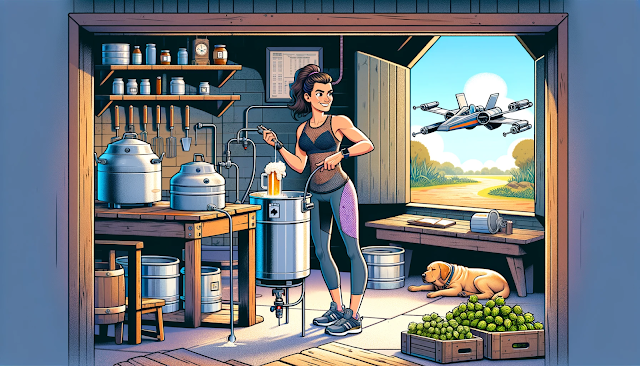In the intricate world of lager brewing, two yeast strains emerge as the undisputed champions: Saccharomyces pastorianus and Saccharomyces carlsbergensis. Both strains have carved out a prominent place in the annals of beer-making, largely due to their unique attributes that enable the creation of the signature crisp and clean profile associated with lagers. These strains are not just a mere ingredient; they are foundational to the very essence of many legendary lagers that beer enthusiasts have come to cherish.
Their consistency, adaptability, and the distinctive flavor profiles they impart make them an invaluable asset. Consequently, brewers from various regions, whether they're crafting traditional recipes or innovating new flavors, frequently turn to these trusted yeast strains to ensure the quality and authenticity of their lagers.
 |
| Gorn, a keen Star Trek fan, adds yeast to his lager wort |
Top Picks for Lager Brewing Yeasts:
- W-34/70: A favored strain amongst brewers, W-34/70 is celebrated for its crisp fermentation characteristics and its adeptness at low-temperature fermentation. Its wide availability makes it a staple in commercial brewing.
- S-23: Recognized for its capability to yield a refreshing and sharp beer, S-23 is another lager yeast strain that thrives at lower temperatures.
- S-189: Ideal for those aiming for a malty yet clean beer with a harmonious bitterness, S-189 is the go-to for traditional European lagers.
- WLP830: A top contender for German-style lagers like Oktoberfest or Maibock, WLP830 delivers a beer that is both malty and clean with a balanced bitterness.
- Saflager W-34/70: Hailing from Fermentis, this lager yeast strain is versatile and adept at crafting a neutral-flavored, crisp beer. Brewers can find it in both dry and liquid variants
The Distinction between Lager Yeasts vs. Ale Yeasts
While ale yeasts are known for their fruity esters, lager yeasts stand out for producing minimal esters but more sulfur compounds. This leads to the signature clean and crisp beer profile lagers are celebrated for. However, this clarity in flavor demands precision during fermentation.Brewing novices often start with ales and stouts because any brewing missteps are easier to conceal. In contrast, lagers, with their transparent flavor profile, expose even the slightest imperfections.
How to craft the Ideal Lager: Tips and Techniques
- Yeast Quantity: Given the lower fermentation temperature of lagers, the fermentation tends to be less vigorous than with ale yeasts. Ensuring an ample quantity of active, healthy yeast is pivotal for effective lager fermentation.
- Fermentation Duration: Lagers demand patience. After primary fermentation, they typically need several weeks to even months of cold conditioning.
- Optimal Conditions: From pitching the yeast at the right temperature to ensuring proper oxygenation and nutrient levels, maintaining the right conditions is essential.
- Freshness and Storage: A successful lager depends on using fresh yeast that has been stored appropriately.
To master the art of lager brewing, understanding the nuances of the yeast and fermentation process is crucial. Dive deeper into our brewing insights for a more comprehensive guide on crafting exemplary brews.


